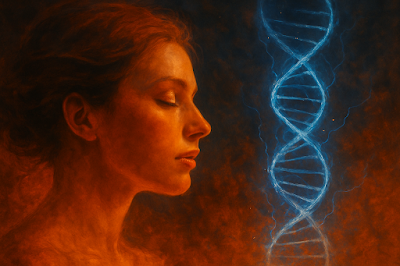There’s something I’ve come to notice about my body—about my being—as the seasons change. From the early days of spring through the thick of summer and into early fall, something stirs inside me. Desire hums. Touch lands differently. Even the wind feels like a flirtation. But come late October, the switch flips. Libido dims. The hum becomes a whisper. By December, I can go days—weeks—without any pull at all.
At first, I thought it was just me. Then I realized it wasn’t. It’s seasonal. It’s hormonal. And it’s part of my womanhood, too.
Winter: When Cortisol Rises, Androgens Fall
Biologically, this pattern makes sense. During winter months, cortisol levels tend to rise—an evolutionary response to reduced light and disrupted circadian rhythms. At the same time, androgens like testosterone and DHEA often decrease. These two forces—cortisol and androgens—are in direct tension with one another. Cortisol is catabolic, a stress signal that breaks down tissue and tells the body to conserve. Androgens are anabolic: builders, motivators, drivers of sexual desire. In women, where androgen levels are already lower compared to men, that winter dip can feel like silence.
And here’s where it gets nuanced: cortisol’s effects are amplified by estrogen. Meanwhile, progesterone can dampen cortisol’s grip—calming the nervous system, promoting GABA, and restoring a kind of internal softness. When progesterone is low and cortisol is high, it doesn’t just mute libido—it can tighten your body into a cold coil of vigilance.
Androgens Ignite. Estrogen Transforms.
From my own experience as a trans woman, I’ve come to understand libido differently than I ever did before. I used to think of desire as pressure—a balloon inflating behind the eyes or between the legs until it had to be let out. It was mechanical. Functional. Maybe feeling a bit frantic.
But estrogen changed everything. Now, libido feels like heat. Not a fire that burns fast, but a slow swelling warmth—like light through a curtain, like breath on glass. It’s not less intense, but it’s more internal. More relational. More about presence than pursuit.
As a big engineering, systems thinking, and metaphors type of person, here’s how I’ve come to think of it...
Libido is like electricity, with how our hormonal components propel and effect it into our being:
- Testosterone is voltage—the raw current, the drive.
- Estrogen is resistance—not in the sense of inhibition, but in the sense of transformation. It reshapes the current. Adds texture. Turns electricity into warmth.
- Progesterone is insulation—protective, soft, quieting the static of cortisol’s alarm bell.
A lot of people think estrogen and androgens directly oppose each other—that they’re on some kind of hormonal tug-of-war. But that’s not quite right. Androgens primarily counteract cortisol and insulin, not estrogen. Estrogen, in fact, tends to encourage both. And that’s exactly why women—cis or trans—need androgens, too.
Not just for libido, but for energy, motivation, metabolic health, even a sense of grounded selfhood. The interplay is layered. These hormones aren’t binary enemies—they’re voices in a chorus, overlapping, harmonizing, counterpointing each other.
Which is why gender—and sex itself—is a spectrum. Not just socially. Biologically. No one is running purely on estrogen or testosterone. We’re all a blend. A pattern. A voltage map lit differently in every body.
The Poetics of Female Desire
There’s something quietly radical about naming these sensations for what they are. About saying, Yes, my desire changes with the seasons. That my body is not broken, just responsive. That libido, for women, isn’t a function to be maintained—it’s an atmosphere. It builds with safety. It deepens with warmth. It hibernates, and then it wakes.
And maybe that’s the real lesson here—not just a chart of hormones or a clinical footnote. But a realization that female libido is so much more nuanced than the way it's brought out in scientific journals that are largely cisnormative, and often still patriarchal. By trans experience, there's a stark contrast. Womanhood isn’t defined by constant arousal or linear drives. It’s defined by resonance—how heat rises, how tenderness blooms, how even quiet can be hold a sort of sensuality
So when winter comes and the voltage dims, I no longer panic. I listen. I rest. I wait for spring—not just outside, but within.
References
- Cortisol's Impact on Insulin Sensitivity – Frontiers in Endocrinology
- Estrogen and Insulin Sensitivity – The American Journal of Pathology
- Testosterone’s Regulation of Cortisol – Nature
- Estrogen and Insulin Action – PubMed Central
- Cortisol – Wikipedia Overview
- Estrogen's Role in Metabolism – Endocrine Reviews

